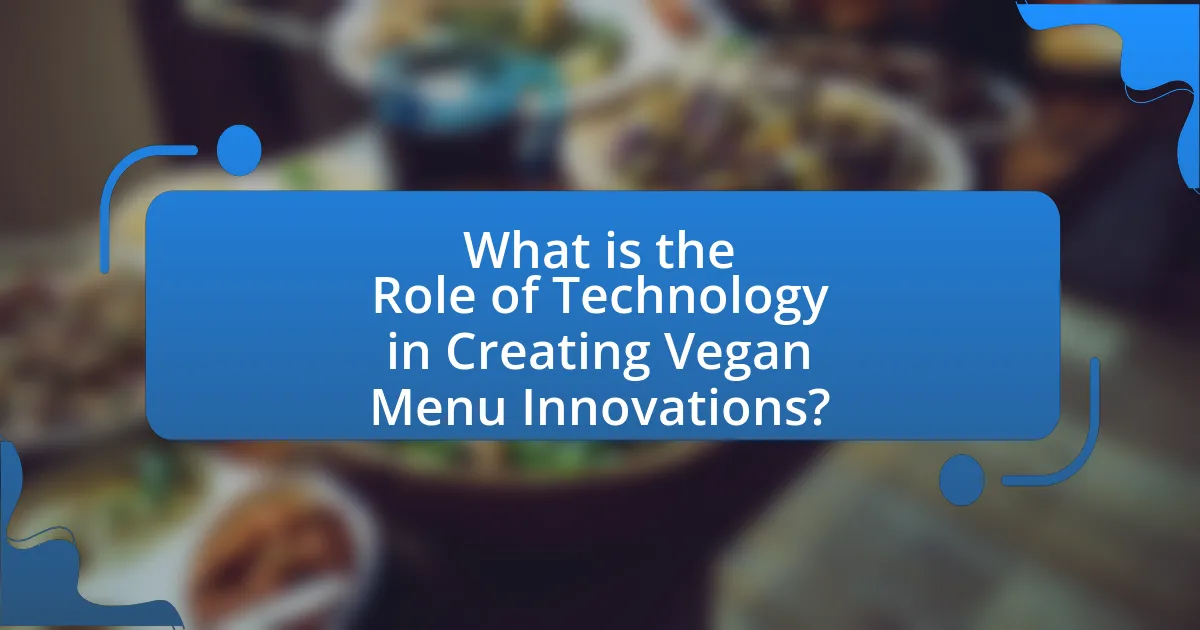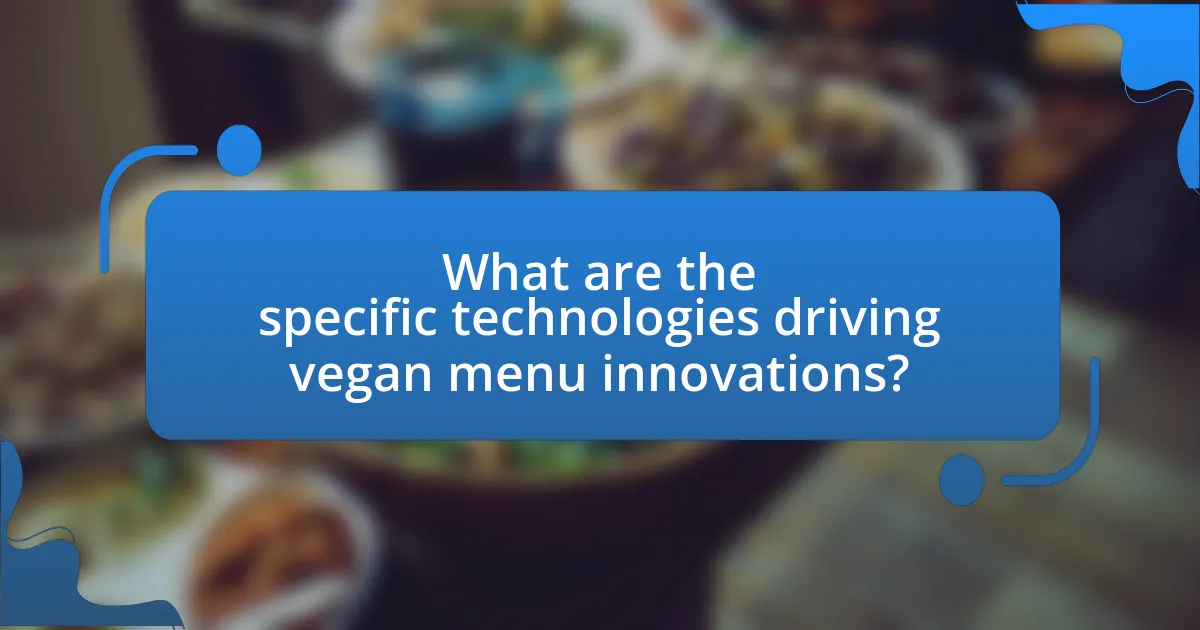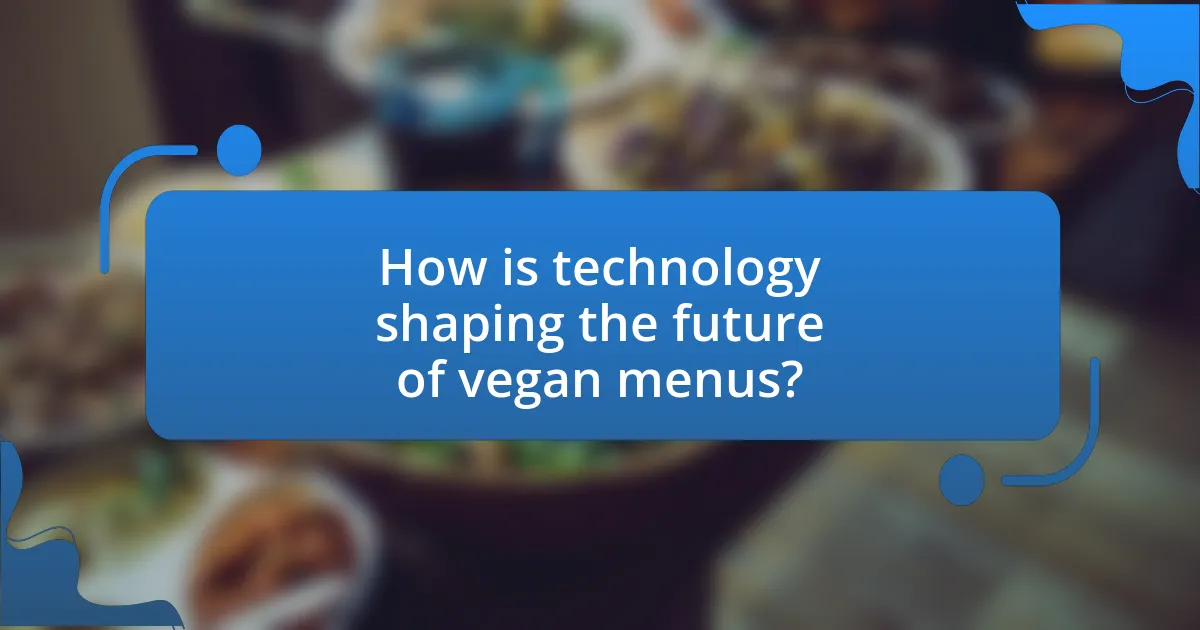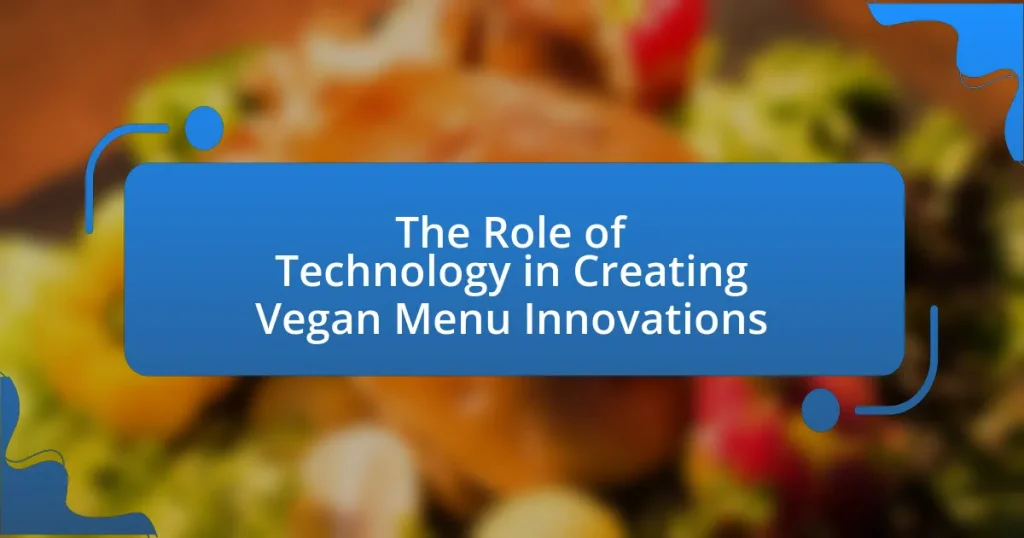The article focuses on the significant role of technology in creating innovations within vegan menus. It highlights how advancements in food science, such as molecular gastronomy, 3D food printing, and biotechnology, enable the development of plant-based alternatives that closely mimic the taste and texture of animal products. Key technologies like data analytics and artificial intelligence are discussed for their ability to analyze consumer preferences and optimize menu offerings, thereby enhancing the appeal and accessibility of vegan dishes. Additionally, the article addresses the challenges chefs face in creating vegan cuisine without technology and outlines specific food processing techniques that improve flavor and texture, ultimately contributing to the growth and sustainability of vegan options in the food industry.

What is the Role of Technology in Creating Vegan Menu Innovations?
Technology plays a crucial role in creating vegan menu innovations by enabling the development of plant-based alternatives that mimic the taste and texture of animal products. Advances in food science, such as molecular gastronomy and 3D food printing, allow chefs and food manufacturers to experiment with ingredients and create novel dishes that appeal to a broader audience. For instance, companies like Beyond Meat and Impossible Foods utilize biotechnology to produce meat substitutes that contain similar protein structures to beef, enhancing consumer acceptance. Additionally, data analytics and artificial intelligence help restaurants analyze customer preferences and optimize menu offerings, ensuring that vegan options meet market demand. These technological advancements not only improve the quality and variety of vegan dishes but also contribute to sustainability by reducing reliance on animal agriculture.
How has technology influenced the development of vegan menus?
Technology has significantly influenced the development of vegan menus by enabling the creation of innovative plant-based ingredients and improving food preparation methods. Advances in food science, such as the development of meat alternatives like Beyond Meat and Impossible Foods, have allowed chefs to replicate the taste and texture of animal products using plant-based ingredients. Additionally, technology in food processing, such as high-pressure processing and fermentation techniques, enhances flavor and nutritional profiles, making vegan options more appealing. The rise of online platforms and apps for recipe sharing and meal planning has also facilitated the accessibility and popularity of vegan cuisine, allowing consumers to easily explore and adopt plant-based diets.
What technological advancements have been pivotal in vegan menu creation?
Technological advancements such as plant-based food processing, 3D food printing, and artificial intelligence have been pivotal in vegan menu creation. Plant-based food processing techniques, including fermentation and extrusion, enhance the texture and flavor of vegan products, making them more appealing to consumers. For instance, companies like Beyond Meat utilize advanced extrusion technology to create meat-like textures from pea protein. Additionally, 3D food printing allows for innovative shapes and presentations of vegan dishes, enabling chefs to experiment with new culinary designs. Artificial intelligence aids in recipe development by analyzing consumer preferences and nutritional data, leading to the creation of tailored vegan options that meet market demands. These advancements collectively contribute to the growth and popularity of vegan menus in the food industry.
How do these advancements enhance the appeal of vegan dishes?
Advancements in technology enhance the appeal of vegan dishes by improving flavor, texture, and presentation. Innovations such as plant-based meat alternatives, developed through techniques like extrusion and fermentation, create products that closely mimic the taste and mouthfeel of animal products, making them more appealing to a broader audience. For example, companies like Beyond Meat and Impossible Foods utilize advanced food science to produce burgers that have a similar juiciness and flavor profile to beef, which has been shown to attract even non-vegans. Additionally, technology in food preparation, such as sous-vide cooking and molecular gastronomy, allows chefs to create visually stunning and flavorful vegan dishes that elevate the dining experience, thereby increasing consumer interest and acceptance.
Why is technology essential for vegan menu innovation?
Technology is essential for vegan menu innovation because it enables the development of new plant-based ingredients and enhances food processing techniques. Advanced technologies, such as molecular gastronomy and food science, allow chefs to create textures and flavors that mimic traditional animal-based products, making vegan options more appealing. For instance, the use of fermentation technology can produce dairy alternatives with complex flavors and nutritional profiles, as seen in products like cashew cheese and almond yogurt. Additionally, data analytics and artificial intelligence can help restaurants analyze consumer preferences, leading to more tailored and innovative vegan offerings. This integration of technology not only improves the quality and variety of vegan menus but also supports sustainability by optimizing resource use in food production.
What challenges do chefs face in creating vegan dishes without technology?
Chefs face significant challenges in creating vegan dishes without technology, primarily due to limitations in ingredient preservation, preparation methods, and flavor enhancement. Without refrigeration or advanced cooking equipment, maintaining the freshness of plant-based ingredients becomes difficult, leading to spoilage and reduced quality. Additionally, traditional cooking techniques may not effectively extract flavors or textures from vegan ingredients, making it challenging to create appealing dishes. For instance, the absence of tools like blenders or food processors limits the ability to create smooth textures or emulsions, which are often essential in vegan cuisine. These constraints hinder chefs’ creativity and ability to deliver diverse and satisfying vegan options.
How does technology help overcome these challenges?
Technology helps overcome challenges in creating vegan menu innovations by enabling the development of plant-based alternatives that mimic the taste and texture of animal products. Advanced food processing techniques, such as extrusion and fermentation, allow for the creation of meat substitutes that appeal to a broader audience. For instance, companies like Beyond Meat and Impossible Foods utilize proprietary technology to produce products that closely resemble beef, which has been shown to increase consumer acceptance and sales. Additionally, data analytics and artificial intelligence assist in understanding consumer preferences, leading to more targeted product development and marketing strategies. This technological integration not only enhances product quality but also streamlines supply chains, making vegan options more accessible and appealing to consumers.

What are the specific technologies driving vegan menu innovations?
Specific technologies driving vegan menu innovations include plant-based protein extraction, fermentation technology, and 3D food printing. Plant-based protein extraction utilizes methods like high-pressure processing to isolate proteins from sources such as peas and soy, enhancing texture and flavor in vegan products. Fermentation technology, including precision fermentation, allows for the creation of dairy-like textures and flavors using microorganisms, which can produce ingredients like casein and whey without animal sources. Additionally, 3D food printing enables the customization of food shapes and textures, allowing chefs to create unique vegan dishes that mimic traditional animal-based foods. These technologies collectively contribute to the expansion and appeal of vegan menus in the food industry.
How do food processing technologies contribute to vegan menu development?
Food processing technologies significantly enhance vegan menu development by improving the texture, flavor, and nutritional profile of plant-based ingredients. These technologies, such as extrusion, fermentation, and high-pressure processing, allow for the creation of meat alternatives that closely mimic the sensory attributes of animal products. For instance, extrusion technology can transform plant proteins into fibrous textures similar to meat, while fermentation can enhance flavors and digestibility, as seen in products like tempeh and plant-based yogurts. Additionally, high-pressure processing preserves nutrients and extends shelf life, making vegan options more appealing and accessible to consumers. These advancements not only cater to the growing demand for plant-based diets but also support the culinary creativity necessary for innovative vegan menu offerings.
What are the key food processing techniques used in vegan cuisine?
Key food processing techniques used in vegan cuisine include fermentation, dehydration, and emulsification. Fermentation enhances flavors and preserves food, commonly applied in products like tempeh and sauerkraut, which utilize beneficial bacteria to transform ingredients. Dehydration removes moisture from fruits and vegetables, concentrating flavors and extending shelf life, often seen in snacks like dried fruit and vegetable chips. Emulsification combines liquids that typically do not mix, such as oil and water, to create dressings and sauces, utilizing ingredients like aquafaba or plant-based emulsifiers. These techniques not only improve the taste and texture of vegan dishes but also contribute to nutritional benefits, making them essential in modern vegan cooking.
How do these techniques improve texture and flavor in vegan dishes?
Techniques such as fermentation, sous-vide cooking, and molecular gastronomy significantly enhance texture and flavor in vegan dishes. Fermentation introduces complex flavors and improves digestibility by breaking down compounds in plant-based ingredients, as seen in products like tempeh and kimchi. Sous-vide cooking allows for precise temperature control, resulting in tender textures and concentrated flavors by evenly cooking vegetables and proteins without losing moisture. Molecular gastronomy employs techniques like spherification and emulsification to create unique textures and flavor experiences, transforming traditional ingredients into innovative forms. These methods collectively elevate the sensory experience of vegan cuisine, making it more appealing and satisfying.
What role does data analytics play in vegan menu innovation?
Data analytics plays a crucial role in vegan menu innovation by enabling restaurants and food companies to analyze consumer preferences, dietary trends, and ingredient availability. By leveraging data analytics, businesses can identify popular vegan ingredients and dishes, optimize their menu offerings, and tailor their products to meet customer demands. For instance, a study by the Plant Based Foods Association reported a 27% increase in sales of plant-based foods in 2020, highlighting the growing consumer interest in vegan options. This data-driven approach allows companies to innovate effectively, ensuring that their vegan menus align with market trends and consumer expectations.
How can restaurants use data to understand customer preferences for vegan options?
Restaurants can use data analytics to understand customer preferences for vegan options by analyzing sales data, customer feedback, and social media interactions. By examining sales data, restaurants can identify which vegan dishes are most popular and adjust their menus accordingly. Customer feedback, collected through surveys or reviews, provides insights into taste preferences and dietary restrictions, allowing restaurants to tailor their offerings. Additionally, monitoring social media trends can reveal emerging vegan food preferences and popular ingredients, enabling restaurants to innovate their vegan menu items. This data-driven approach is supported by research indicating that 39% of consumers are actively trying to incorporate more plant-based foods into their diets, highlighting the importance of understanding these preferences for menu development.
What insights can data analytics provide for menu optimization?
Data analytics can provide insights for menu optimization by identifying customer preferences, analyzing sales trends, and evaluating ingredient costs. By examining historical sales data, restaurants can determine which vegan dishes are most popular, allowing them to focus on high-demand items. Additionally, data analytics can reveal seasonal trends, helping establishments adjust their menus to align with customer tastes throughout the year. Furthermore, analyzing ingredient costs enables restaurants to optimize pricing strategies and reduce waste, ultimately improving profitability. For instance, a study by the National Restaurant Association found that 70% of consumers are more likely to visit a restaurant that offers healthy options, highlighting the importance of data-driven menu decisions in attracting customers.

How is technology shaping the future of vegan menus?
Technology is shaping the future of vegan menus by enabling the development of innovative plant-based ingredients and enhancing food personalization. Advances in food science, such as fermentation and cellular agriculture, allow for the creation of meat alternatives that closely mimic the taste and texture of animal products, making vegan options more appealing to a broader audience. For instance, companies like Impossible Foods and Beyond Meat utilize biotechnology to produce plant-based proteins that have gained significant market traction, with sales reaching over $1 billion in 2020. Additionally, data analytics and artificial intelligence are being employed to analyze consumer preferences, allowing restaurants to tailor their vegan offerings to meet specific dietary needs and trends, thereby increasing customer satisfaction and engagement.
What emerging technologies are expected to impact vegan menu innovations?
Emerging technologies expected to impact vegan menu innovations include plant-based meat alternatives, precision fermentation, and artificial intelligence in food development. Plant-based meat alternatives, such as those produced by companies like Beyond Meat and Impossible Foods, utilize advanced food science to create products that closely mimic the taste and texture of animal meat, appealing to a broader consumer base. Precision fermentation technology allows for the production of dairy proteins and other ingredients without animal sources, enhancing the flavor and nutritional profile of vegan dishes. Additionally, artificial intelligence is being employed to analyze consumer preferences and optimize recipes, leading to more innovative and appealing vegan menu options. These technologies collectively contribute to the growth and diversification of vegan offerings in the food industry.
How might artificial intelligence influence recipe development for vegan dishes?
Artificial intelligence can significantly influence recipe development for vegan dishes by analyzing vast amounts of data to identify flavor pairings, nutritional content, and ingredient substitutions. AI algorithms can process existing recipes, consumer preferences, and dietary restrictions to generate innovative vegan recipes that cater to specific tastes and health needs. For instance, a study by the University of California, Berkeley, demonstrated that machine learning models could predict successful ingredient combinations based on historical data, leading to the creation of unique and appealing vegan dishes. This data-driven approach not only enhances creativity in recipe formulation but also ensures that the resulting dishes meet nutritional standards and consumer demands.
What potential does 3D food printing hold for vegan cuisine?
3D food printing holds significant potential for vegan cuisine by enabling the creation of complex textures and flavors that mimic traditional animal-based products. This technology allows for precise control over ingredient composition, facilitating the development of plant-based alternatives that can replicate the sensory experience of meat, dairy, and eggs. For instance, research has shown that 3D printing can produce plant-based meat substitutes with layered structures that enhance mouthfeel and taste, addressing common consumer concerns about the texture of vegan foods. Additionally, 3D food printing can reduce food waste by utilizing by-products and less desirable ingredients, thus promoting sustainability within vegan culinary practices.
What best practices should restaurants follow to leverage technology in vegan menu creation?
Restaurants should utilize data analytics, digital platforms, and innovative cooking technologies to enhance vegan menu creation. Data analytics allows restaurants to understand customer preferences and trends, enabling them to tailor their vegan offerings effectively. For instance, a study by Technomic found that 40% of consumers are interested in plant-based options, highlighting the demand for vegan dishes. Digital platforms, such as menu management software, can streamline the process of updating and optimizing vegan menus based on seasonal ingredients and customer feedback. Additionally, innovative cooking technologies, like sous-vide and 3D food printing, can help chefs create unique textures and flavors in vegan dishes, making them more appealing. By integrating these technologies, restaurants can improve their vegan menu offerings and meet the growing consumer demand for plant-based options.
How can restaurants effectively integrate technology into their kitchen operations?
Restaurants can effectively integrate technology into their kitchen operations by adopting kitchen display systems (KDS), inventory management software, and automated cooking equipment. Kitchen display systems streamline communication between front-of-house and back-of-house, reducing order errors and improving efficiency. Inventory management software helps track ingredient usage and minimize waste, which is crucial for maintaining a sustainable vegan menu. Automated cooking equipment, such as sous-vide machines and induction cooktops, enhances precision in cooking, ensuring consistent quality in vegan dishes. According to a study by the National Restaurant Association, 70% of restaurant operators believe that technology improves their kitchen efficiency, demonstrating the tangible benefits of these integrations.
What strategies can enhance customer engagement with vegan menu innovations?
Implementing interactive digital platforms can significantly enhance customer engagement with vegan menu innovations. These platforms, such as mobile apps and social media, allow customers to provide feedback, share experiences, and participate in polls or contests related to new vegan offerings. For instance, a study by the Food Marketing Institute found that 70% of consumers are more likely to engage with brands that utilize interactive technology. Additionally, leveraging augmented reality (AR) to showcase vegan dishes can create immersive experiences, making customers more likely to try and share these innovations. This approach not only increases visibility but also fosters a community around vegan cuisine, driving higher engagement levels.


